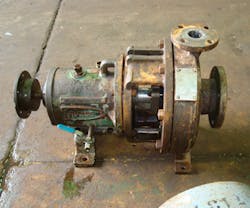Larry Bachus
(a.k.a. “Pump Guy”)
Let’s go back in time – to the dark ages before cell phones and the Internet – and I’ll tell you the story of the hot-acid slurry.
A young, energetic mechanical seal salesman visits the engineer at a chemical plant. Due to recently enacted laws governing the environment and pollution, the plant engineer is converting the pumps in his plant from packing to mechanical seals. The engineer tells the young salesman he’ll convert the chemical plant to the salesman’s brand of mechanical seal, if the salesman can seal the most difficult application in the plant … the hot-acid slurry pump out by the railroad tracks in the back of the plant.
As they walk through the plant toward the hot acid slurry pump, they pass 50 “easy-to-seal” water pumps. The young salesman salivates at the thought of selling 50 seals and dreams of buying a new car … if he can only make a cartridge seal stick on that menacing hot-acid slurry pump.
The young salesman’s enthusiasm blinds him to the fact that the plant engineer has absolutely no intention of converting the water pumps to the salesman’s brand of mechanical seal. The engineer is satisfied with the service life of the seals on the other pumps. But that hot-acid slurry has proven difficult to seal. Every other brand of seal had crapped out after a few days on that hot-acid slurry. All the other seal salesmen walked away frustrated. The engineer just wants to see if the new seal and the new seal salesman have something to offer.
It so happens that the correct model of seal is on the distributor’s shelf. It has the correct metallurgy, the correct face combination, the correct secondary seals, the correct spring arrangement, and the correct size for the pump shaft and bolt circle for the gland studs.
The young salesman gingerly opens the seal box and inspects the cartridge seal, nested into the custom molded foam packing. Everything is perfect. The salesman worries about the company driver and delivery truck, so he decides to personally deliver the seal.
At 5:30 a.m. on the day the seal is to be installed, the salesman places the seal in the passenger seat of his car, wraps and clicks the passenger seatbelt around the seal box, and escorts the seal to the chemical plant.
At the chemical plant, the young salesman stays close to the shop mechanics and verifies that the new pump shaft and impeller are straight, aligned, and balanced, and that the new bearings are properly installed and lubricated. The shop mechanics step back and the young salesman slides the seal onto the shaft, taking care not to nick or slice the shaft o-ring as it passes the woodruff key groove and the shaft shoulder.
With the cartridge seal on the shaft, the young salesman carefully slides the seal chamber/back plate onto the shaft and bolts the assembly to the mounting collar. Then, the shop mechanics step forward and mount the impeller onto the shaft and set the impeller to the back plate. The salesman bolts the seal to the chamber, tightens the set-screws, and pulls the plastic clips, activating the spring tension and seal face closing force.
The pump’s power end is taken to the site and mounted into the volute, shimmed, and aligned with the motor shaft. The pump starts.
Amazingly, the seal is still running and sealing 6-months later on the hot-acid slurry with no weeping or drips. The other seals had spewed and crapped out at two to three weeks running time.
The young salesman approaches the plant engineer and reminds him of his offer to convert the plant and the other 50 pumps to the salesman’s seals. The engineer says the seal is still under test. He wants to study the seal a little more on the hot-acid slurry before making any changes to the other pumps.
Three years pass since the installation. The seal continues to seal and contain the hot-acid slurry. Then, one day the salesman’s desk phone rings. The plant engineer calls and says the seal failed the previous evening and spewed hot acid all over the ground and the electric motor. The test is over. The seal failed. Forget about converting the plant to the salesman’s mechanical seal.
The salesman licks his wounds, picks himself up and visits a new customer, the plant engineer in another chemical plant. The plant engineer tells the salesman he’ll convert the chemical plant to the salesman’s brand of mechanical seal, if the salesman can seal a difficult application out in the back of the plant … a hot-acid slurry pump.
As they walk through the plant toward the hot-acid slurry pump, they pass 80 cold water pumps. The salesman notices the “easy-to-seal” pumps, this time without emotion. As they arrive at the hot-acid tank and pump, the salesman immediately exclaims, “Oh, that’s an easy pump to seal. I know how to seal that hot-acid slurry. I have just the seal for that pump. It’s an easy application.”
The engineer says, “But this hot-acid slurry destroyed your competitor’s mechanical seals in a few hours, and frustrated the other suppliers.” He repeats again that he’ll convert the whole plant to the salesman’s seals if he can seal that hot-acid slurry.
The salesman says, “It doesn’t work that way. If I seal this pump, you don’t improve your knowledge. It is more important for your maintenance workers to know how to seal that pump. Besides, you can’t decide to convert the whole plant to my seal based on the performance of one seal in one pump. You’ll want a random sample and those 80 random water pumps will provide the sample.”
The astute salesman continued, “At some point that pump’s going to leak again, and I may not be available to come and fix it. Your people need to know how to seal it. As they say, I can give you a fish and you’ll have food for a day. Or, I can teach you how to fish, and you’ll have food for the rest of your life. I’ll teach your people to seal that acid pump with my seal and we’re gonna practice on your 80 cold water pumps.”
The engineer says, “I’m really anxious to seal that hot-acid slurry. The EPA’s on my back for fugitive emissions and contaminating the ground water.” The salesman responds, “Then we better get started. Call me as soon as a seal fails on any one of those 80 cold-water pumps. When your people are adept at installing my seals onto a standard pump, then we’ll step-up to the hot-acid slurry pump with insured success.”
The salesman gave his brand new cellphone number to the engineer, drove home in his Jaguar sedan, and took his wife to a fancy restaurant for a romantic candle-lit lobster dinner. And they all lived happily and prospered ever after.
The above article is a hypothetical response to a recent e-mail I received in my inbox. A paraphrased version of the e-mail inquiry is provided below.
Oct 8th, 2010
Hi Larry,
I work in sales for a mechanical seal distributor. One of my customers has a challenging application. They are pumping 30 percent hydrochloric acid (HCL) at 185 F, with mineral, sediment, and crystal slurry particles up to maybe one-half inch diameter.
I spoke with my supplier. My supplier makes a chemical seal but no slurry seal. They indicated their chemical seal would be destroyed with the slurry.
Do you have any experience with such a service? Any insight would be helpful.
Thanks,
A Young Mechanical Seal Salesman
Larry Bachus, founder of pump services firm Bachus Company Inc., is a regular contributor to Flow Control magazine. He is a pump consultant, lecturer, and inventor based in Nashville, Tenn. Mr. Bachus is a retired member of ASME and lectures in both English and Spanish. He can be reached at [email protected].





